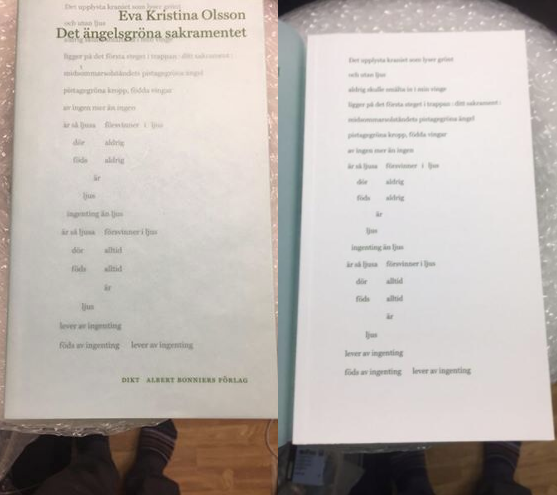Originally published in Dagens Nyheter, June 12, 2017
Translated by Johannes Göransson

Why are so many people angry at poetry? Even the poets hate their form of expression. The poet Anna Axfors wrote this in Expressen: “To read poetry regularly has the tristesse of assembly-line-dating to find the right one.” Poetry is frustrating. It isn’t always easy to tell which books are written with extreme precision (good!), and which ones are vague (bad!).
Some poetry is research that is all about fine-tuning the words so that they reveal the nuances of reality. But many readers don’t understand such nuances; they simply can’t follow along with the new discoveries. Instead they get angry and shout “pretentious!” Other poems are satisfied with mystification. The words may feel beautiful, sensitive and riddle-like, though you don’t need to worry about what they are saying. Hyper sensitivity as pose. So depressing.
It’s also hard to determine which poems actually take on risky reality work and which ones merely pick up free points from being dreamily unfocused. What I know for certain about Eva Kristina Olsson, an utterly wild and mad poet, is that she is one of the most precise poets around. She is so good at fine-tuning reality that she dares to throw herself into subject matters on the border of hazy mysticism.
What other serious poets willingly write about angels? OK, you’re going to drag Rilke into this. But that was a long time ago. These days angels are associated with New Age and Norwegian princesses. All reasonable poets turn and run when the subject of angels comes up. But not Eva Kristina Olsson. And she’s up to the task. She’s putting the old, slackened religious symbols back to work in revealing reality.
The new book, The Angelgreen Sacrament, comes with a bluish transparent cover, thin and fragile like the gown of an angel. The poems start already with the cover. The text is printed in green.
Olsson works with images, colors, light and movement. She is also a choreographer and you can tell from her books. Her poetry has more in common with dance than with prose. This is how the book begins: “The illuminated cranium which glows green / and without light / would never melt into my wing / lies on the first step of the stairs : your sacrament : / the midsummersolstice’s pistachiogreen angel / pistachiogreen body, born wings / of no one more than no one.” The stage is a heavenly stairway; the angel is born, gooey and grasshopper-like, from the pupa, a perpetual motion machine that lives on light and nothingness.
“To the angels and my first twelve years” it says on the back cover of the book. The child does not lie. The child is concrete even when dealing with things of utter complexity: “I came to earth to see a pearl hyacinth.”
Throughout the book, the poem moves step by step up a stairway, maybe a stair of aging or a love story, in a slow ascent in which the green is a kind of birth slime. “Don’t be afraid / you are afraid / now I take the first step / now I stand on the first step.” The life force is taken in laboriously or perhaps slowly, and sometimes Olsson touches the repulsive thing: “the just now green twelve-year-old fetus.”
Olsson’s torturously beautiful ascent has a hard lightness, just like real life. And when one is in those rare moments actually permeated by the arrow’s tip of poetry, then one cannot be angry anymore. Rarely have I ever seen so clearly the distinction between the real and mystification. I just have to capitulate. Eva Kristina Olsson has written the best poetry collection of the year.
Aase Berg is the author of ten books, including most recently Hackers and the controversial autofiction The Hag. Several of her books have been published in English translation: Remainland: Selected Poems of Aase Berg, With Deer, Dark Matter, Transfer Fat, and Hackers. She has won numerous awards for both her poetry and criticism.
Johannes Göransson is the author of eight books – including most recently POETRY AGAINST ALL and Transgressive Circulation: Esssays on Translation – and the translator of many more, including books by Aase Berg, Ann Jäderlund, Kim Yideum and Henry Parland. He edits Action Books and teaches in the MFA program at the University of Notre Dame. @JohannesGoranss